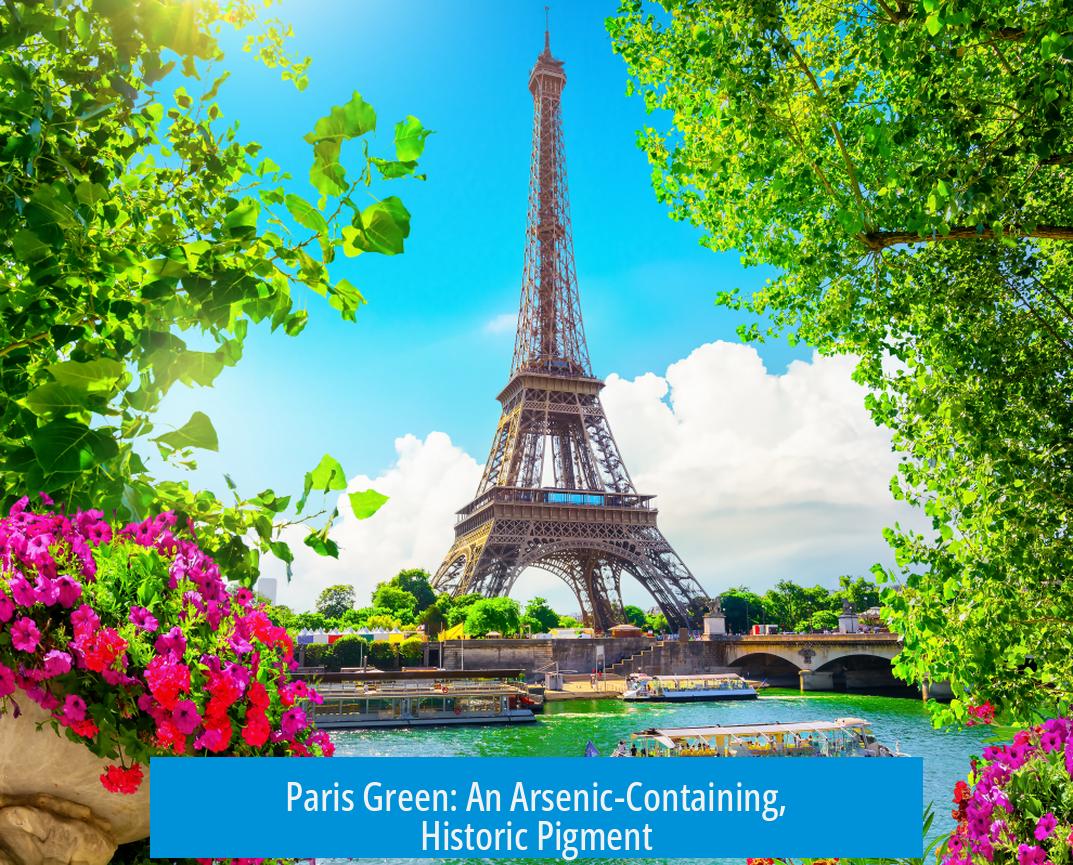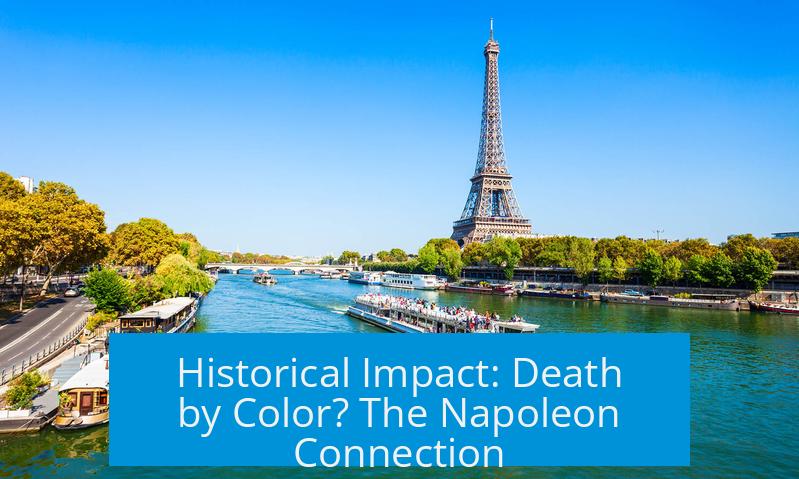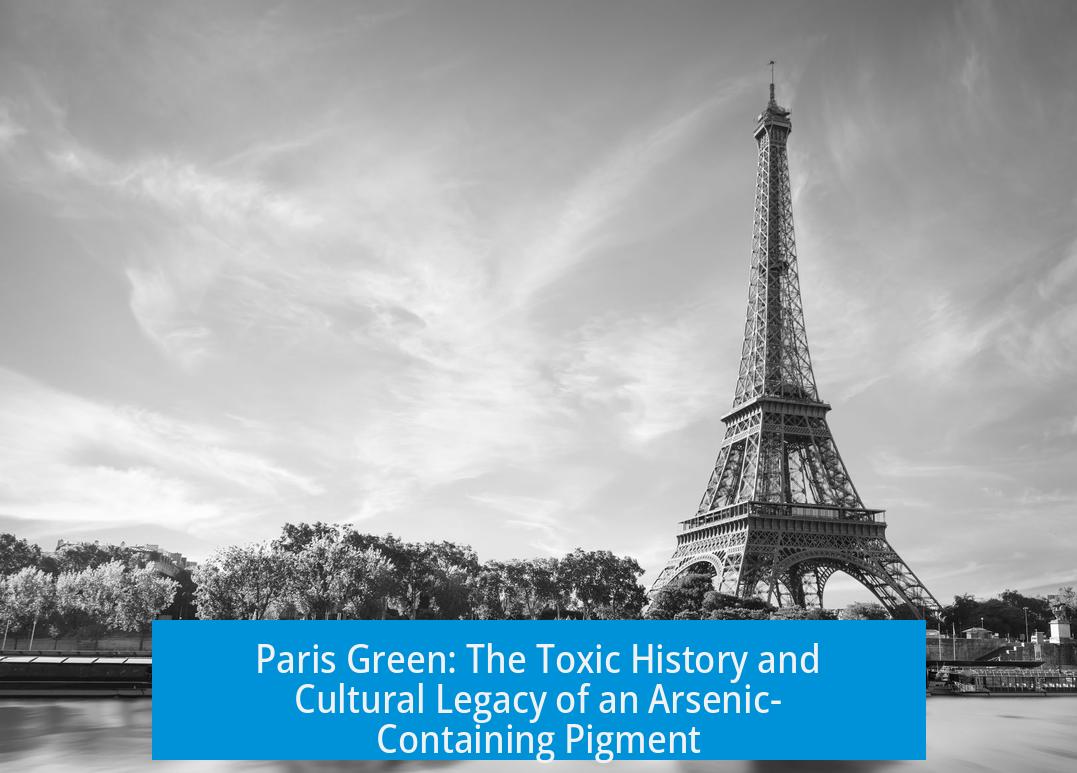Paris Green: An Arsenic-Containing, Historic Pigment

Paris green is a vivid, historic pigment composed of copper(II) acetoarsenite, well known for its intense green color and high toxicity due to arsenic content. This pigment, also called “Schweinfurter Grün,” was widely used in art and industry but is now obsolete due to safety concerns.
Chemical Composition and Properties
Paris green’s chemical formula is roughly Cu(C_2H_3O_2)_2·3Cu(AsO_2)_2. It contains copper cations and arsenite anions, forming a complex crystalline structure. The pigment is notable for its high arsenic and oxygen content, which contributes to its chemical instability and toxicity. Exposure to humidity can cause arsenic compounds to leach out, releasing arsenic hydride gases, which smell like garlic.
Toxicity and Historical Impact
Paris green’s toxicity is extreme. It can release deadly arsenic compounds, causing poisoning through inhalation, ingestion, or skin contact. Historically, it has been implicated in severe health issues. For example, the pigment coated the walls of Napoleon Bonaparte’s exile room on Saint Helena. The humid environment caused arsenic leaching, which allegedly contributed to his death.
Its toxicity led artists and manufacturers to avoid or ban it. It was also a hazard in studios—famous painters like Jackson Pollock had Paris green cans in their studios, posing risks unknowingly. Safe removal requires expert handling to avoid exposure.
Uses and Modern Replacements
Paris green was popular in the 19th century for painting and fireworks, particularly for producing brilliant hues in pyrotechnics. However, environmental and health concerns pushed its replacement. Modern alternatives such as chromium oxide green (Cr_2O_3) or mixing safer pigments like methylene blue with yellows now provide similar green shades without arsenic risks.
Cultural Legacy

Despite the dangers, Paris green remains fascinating due to its rich color and historical significance. It is referenced in various cultural contexts, including art and film, representing a ‘poisonous’ aesthetic. Its distinct shade cannot be fully replicated by modern color codes.
Key Takeaways
- Paris green is a copper-arsenic pigment known for its toxicity.
- Its chemical makeup involves copper cations and arsenite anions.
- Historical use led to arsenic poisoning, including possible impact on Napoleon.
- Replaced by safer green pigments due to environmental and health dangers.
- Its vivid color still fascinates artists and historians despite risks.
Paris Green: The Toxic Charm of an Arsenic-Containing, Historic Pigment
Paris green is an arsenic-containing pigment famous for its vivid, toxic allure. This historic pigment, once beloved for its unique shade and brilliance, now serves as a cautionary tale due to its extreme toxicity. Although it’s no longer sold, its fascinating story and impact linger in art, history, and even toxicology discussions.
If you’ve ever wondered why some old walls “smell like garlic,” you might be smelling arsenic hydrogen gas from Paris green—yep, that lovely poison from the past. Let’s dive into why this pigment is both mesmerizing and downright dangerous.
The Beguiling Beauty and Composition of Paris Green
Paris green, also known as “Schweinfurter Grün,” boasts a shade of green so vivid it looks like it waltzed right out of a fantasy—or a poison bottle in a movie. It’s no surprise that artists and chemists alike had a love/obsession with this color. Thinking #50C878 (a hex code for “medium sea green”) captures its brilliance? Nah, it only hints at the glow that Paris green offers—but, hey, it comes with zero toxicity.
From a chemistry perspective, Paris green is a copper acetoarsenite compound containing copper cations (Cu2+) and arsenic anions combined with oxygen. The alloy of copper, arsenic, and oxygen is a bit unusual as both components are anions, but those copper cations hold the pigment together. If you ever wondered how it stays stable with all those anions bunched up, remember those copper ions are the glue.
Something else to picture: the pigment carries a hefty dose of oxygen. Imagine lighting it up—would it burn fiercely? Spoiler: it definitely could ignite fumes hazardous to health. Plus, the deadly arsenic trioxide involved in its synthesis sets off alarm bells in any chemist’s head.
Historical Impact: Death by Color? The Napoleon Connection

Paris green’s toxicity is not just theoretical. Legend claims this pigment could have been a slow assassin. Napoleon Bonaparte, during his second exile on Saint Helena, supposedly spent time in a room painted with Paris green. The pigment’s arsenic leached into the damp walls and air, contributing to his demise. It’s an atmospheric killer, literally seeping poison over time.
Poisonous history aside, Paris green finds mention in surprising places. For example, the great American painter Jackson Pollock apparently had cans of it in his studio. A sinister souvenir or a nod to art’s complex relationship with materials? Either way, it’s a pigment that carries a whiff of danger in every pinch.
Worried about finding it in your old piano or walls? It’s best handled by professionals. Safe removal involves specialized precautions since disturbing arsenic pigments can release harmful dust and gas. Definitely don’t try this as a weekend project.
Paris Green’s Evolution: From Toxicity to Safer Alternatives
In its heyday, Paris green dazzled not only on canvases but also in pyrotechnics. It was prized for producing some of the most dazzling blues in fireworks displays, a surprise given its green hue! Unfortunately, its environmental and health risks forced a phase-out. Luckily, science found safer replacements just a few years ago, sparking blue fireworks without poisoning the air.
Wondering if mixing Paris green with methylene blue neutralizes its toxicity? Unfortunately, toxicity isn’t that easy to mask. The arsenic component remains hazardous regardless of mixtures.
Today, artists and manufacturers turn to non-toxic pigments like chromium oxide green (Cr2O3) or Rinman’s green. When creativity calls, mixing simple blue and yellow paints can also do wonders without the poison.
Culture, Curiosities, and That Ongoing Fascination
Culturally, Paris green holds a strange spot. It isn’t available on Amazon anymore (surprise!), yet it’s evoked in tales, personal anecdotes, and even memories of Nickelodeon slime—someone’s wild imagination linking toxic pigment to childhood goo. The pigment’s uncanny vividness remains a point of fascination, enough to inspire usernames and quirky references like “color my green eggs and ham with it.”
Still curious about Paris green, its deadly reputation, or the chemistry behind its vibrant color? Some vintage chemistry enthusiasts like Thyzoid (mysterious, right?) often surface in discussions, bringing history and science together in a quirky, slightly unnerving package.
So What Can We Learn from Paris Green?
Paris green showcases the double-edged sword of innovation. A pigment that enchants with beauty but delivers lethal consequences is a cautionary emblem. It pushes us to think: when is beauty worth the risk? And can we find joy in colors without inviting danger?
Today, Paris green is a relic that teaches chemistry, history, and art lovers vital lessons. It reminds us that behind some historic materials lies a hidden toxicity that fuels dramatic stories—Napoleon’s alleged poisoning, artistic brilliance, and advances in pigment technology.
Next time you admire a vivid green paint, pause and appreciate how far we’ve come from arsenic-laced hues to safe, eco-friendly colors. Isn’t it fascinating how a pigment can tell a story spanning centuries, chemistry labs, toxic legends, and fireworks displays?
Quick Tips for Anyone Encountering Paris Green
- If you discover Paris green in antiques or old architecture, do not touch or disturb it.
- Consult professionals for safe removal—this pigment is no joke.
- When choosing green pigments for projects, prioritize non-toxic modern alternatives.
- Respect the pigment’s history even as you enjoy safer colors today.
So, what’s your take? Would you want a hint of Paris green’s unique shade in your art, knowing its history? Or does its poison past make it forever off-limits? Share your thoughts—there’s no wrong answer to loving a color with such a storied past.
What made Paris green so toxic compared to other pigments?
Paris green contains arsenic, a highly poisonous element. Its arsenic can leach into surroundings, especially in damp conditions. This made it dangerous to use and handle.
How was Paris green linked to Napoleon’s death?
Napoleon’s exile room was reportedly painted with Paris green. The moisture caused arsenic to release slowly into the air. Some believe this contributed to his long-term poisoning.
Can Paris green still be safely removed from old objects or buildings?
Removing Paris green is risky due to its arsenic content. Proper protective gear and professional methods are needed. It’s best to avoid DIY removal to prevent exposure.
What replaced Paris green in art and fireworks?
Safer green pigments like chromium oxide and Rinman’s green replaced Paris green. Blue fireworks once used Paris green, but recent alternatives now create safer colors without toxicity.
Why was Paris green favored despite its toxicity?
Its vivid and unique shade of green was hard to match. Artists and manufacturers prized its brightness before fully understanding its dangers. The color remains distinctive in pigment history.





Leave a Comment